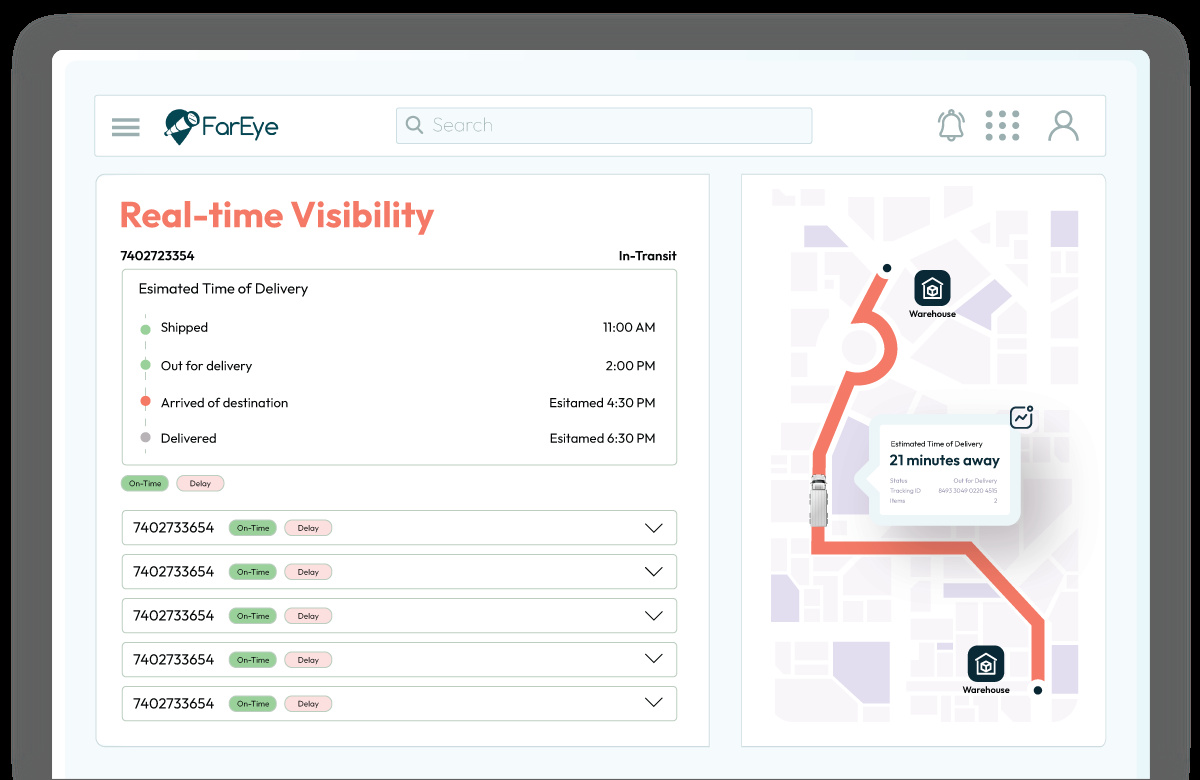- Route
Cutting Costs and Improving Delivery Times with Trucking Dispatch Software
Table of Contents
- Understanding the Rising Costs in Trucking
- What Is Trucking Dispatch Software?
- How Trucking Dispatch Software Cuts Costs?
- Accelerating Delivery Times with Advanced Route Planning
- The Importance of Comprehensive Truck Routing
- FarEye: Addressing Complex Routing Needs
- Best Practices to Maximize Results
- Ready to Transform Your Operations with Trucking Dispatch Software?

A logistics company is on the verge of losing a key contract due to repeated delivery delays. Dispatchers struggle with last-minute route changes and driver unavailability, while customers demand faster shipping times and real-time updates.
According to a report, trucks move over 72.6% of the nation’s freight. Yet operational costs continue to rise, and many carriers struggle to meet stringent delivery windows without draining their budget. Rising fuel prices, underutilized backhauls, and compliance complexities add to the challenges.

Manual dispatching can’t keep pace with same-day or next-day delivery demands. Fortunately, trucking dispatch software offers a practical way to optimize costs, boost driver productivity, and shorten delivery times. With the right solution, carriers can map out strategic routes, manage driver availability, and update customers—instantly.
This blog explores how dispatch platforms cut expenses and speed up distribution across the supply chain.
Understanding the Rising Costs in Trucking
Freight transportation is often a major expense for supply chain operations. Findings suggest that trucking companies can spend more than $2.270 per mile on expenses like fuel, maintenance, driver wages, and regulatory compliance. Many fleets operate under tight margins, so wasteful routes or extended idle times can quickly erode profits.
At the same time, consumer expectations for immediate deliveries are driving logistics managers to tighten schedules. Each delayed shipment leads to customer dissatisfaction and lost revenue. Trucking dispatch software serves as a modern solution, automating route assignments and instantly sharing delivery updates so everyone stays informed. Shorter wait times, fewer empty miles and accurate load matching help minimize overhead costs.
What Is Trucking Dispatch Software?
Trucking dispatch software is a specialized platform that streamlines core trucking operations—from assigning loads to drivers to tracking shipments and optimizing routes. It has become the best truck dispatching software for reducing inefficiencies and boosting on-time performance.
For fleets seeking dispatch software for small trucking companies, it levels the playing field by delivering sophisticated capabilities previously accessible only to large enterprises.
Common features include:
- Load and Order Management: Consolidates shipment data and assigns the right vehicle based on capacity and proximity.
- Route Optimization: Factors in traffic, vehicle size, driver schedules, and weather to plan efficient paths.
- Driver Hours Compliance: Monitors rest periods and drive times to meet Department of Transportation (DoT) standards.
- Real-Time Fleet Visibility: Tracks truck locations through GPS or telematics devices.
- Customer Notifications: Provides updates on ETAs, delays, and completed deliveries, fostering transparency.
By replacing manual processes with automation, trucking dispatch software simplifies workflows, ensures data accuracy, and allows dispatchers to address real-time challenges in an agile manner.
How Trucking Dispatch Software Cuts Costs?
Trucking dispatch tools slash operational spending by streamlining every stage of the delivery journey. Here are several ways they help carriers preserve their bottom line.
- Better Fleet Utilization
When vehicles run below capacity or return empty, operating costs climb fast. A robust dispatch tool automates load matching so carriers can pair open trucks with available freight. Route optimization ensures pickups and deliveries fit seamlessly into existing schedules. This approach reduces empty backhaul, cuts down on driver idle time, and keeps resources engaged. - Reduced Fuel Expenses
Fuel is among the largest expenses for trucking operations. Minor inefficiencies—like small route deviations or prolonged waits—can push monthly fuel bills higher. Route optimization features generate trip plans that circumvent known bottlenecks. They also consider travel times, road closures, and rest breaks so drivers aren’t stuck in lengthy rush-hour queues. Over time, these tweaks lead to noticeable savings in fuel consumption. - Lower Administrative Costs
Manual dispatching is time-consuming, requiring countless phone calls, paper logs, and back-and-forth coordination. Automated platforms handle much of this workload, including driver scheduling, electronic proofs of delivery, and real-time order updates. This frees dispatchers to focus on higher-value tasks like analyzing operational data or improving driver retention programs. - Dynamic Scheduling
Trucking dispatch software helps carriers adapt to last-minute changes. If a customer requests an urgent order, the system can recalculate routes and assign a driver with open capacity. This flexibility prevents resource wastage and boosts revenue by letting companies handle extra shipments whenever possible. - Regulatory Compliance
Hours-of-service (HOS) violations can lead to hefty fines and legal complications. Automated platforms track each driver’s on-duty time and rest periods, alerting dispatchers when a driver is close to hitting legal limits. This reduces compliance risks while keeping both trucks and drivers operating safely.
Accelerating Delivery Times with Advanced Route Planning
Speed is critical in modern logistics. Below, we explore how trucking dispatch software leverages real-time data to enable efficient route planning and keep deliveries on schedule.
- Real-Time Traffic and Weather Data
Quick deliveries hinge on smart routing decisions. Trucking dispatch software uses live traffic data and weather alerts to adjust routes in real time. If a road is closed or a storm hits, dispatchers can reroute to avoid major disruptions and keep deliveries on schedule. - Multi-Stop Optimization
Handling multiple pickups and drop-offs in one trip can be complex. Dispatch platforms arrange stops to minimize wasted distance. They consider vehicle capacity, average loading times, and required SLAs. Drivers finish runs sooner, and dispatchers can fit more orders into a single day. - Consistent Fleet Visibility
Accurate, instantaneous updates eliminate the guesswork of manual tracking. If a driver faces a delay, dispatch sees it. If a truck becomes available earlier than planned, dispatchers know and can assign a new job. Real-time data keeps schedules tight and on track. - Automated Load Matching
The right load must reach the right driver without delay. Automated load matching pairs shipments with optimal routes and vehicles, which makes scheduling immediate. This reduces administrative overhead and speeds up deliveries.
The Importance of Comprehensive Truck Routing
Routing is more than choosing the shortest path on a map. Modern dispatch solutions evaluate multiple constraints that impact safety, costs, and timelines:
- Order Parameters
Shipments vary in size, weight, and handling needs. Truck routing solution factors in load dimensions and delivers custom ETAs based on freight specifics. - Vehicle Parameters
Trucks differ in length, height, and cargo capacity. Large trailers might not fit under certain overpasses, and some roads ban hazardous materials. Dispatch software pre-checks these details to avoid mid-trip complications. - Road Parameters
Bridges, tunnels, and restricted roads can cause last-minute detours. Advanced routing tools account for these constraints from the outset. They deliver accurate estimates of arrival times and ensure safer, more reliable routes. - Driver Parameters
If drivers need rest stops or have HOS limitations, the system integrates those requirements into each route plan. This prevents scheduling conflicts and keeps operations aligned with DoT guidelines.
FarEye: Addressing Complex Routing Needs
FarEye stands out as a comprehensive solution for FTL (Full-Truckload) and LTL (Less-than-Truckload) operations:
- FTL Routing
- Multi-Day Planning: Coordinate routes that span multiple days, including overnight rest stops.
- Dedicated Capacity: Match high-value cargo with the right trucks for a secure, on-time journey.
- Driver Hours Compliance: Integrate HOS and rest breaks directly into routing logic.
- LTL Routing
- Multi-Stop Optimization: Consolidate shipments to reduce partial loads and lower transit costs.
- Real-Time Visibility: Monitor progress and anticipate delays via a user-friendly dashboard.
- Load Optimization: Combine shipments whenever possible to maximize every trip.
- Multiple Constraints
- Order, Vehicle, and Road Factors: Incorporate weight limits, dimensions, and route restrictions.
- Driver Management: Schedule breaks, plan fueling stops, and comply with labor laws.
- Scalable Architecture: Whether you run 10 trucks or 1,000, FarEye adapts to changing needs.
- Core Benefits
- Reduce Empty Backhaul: Use return trips more effectively.
- Minimize Idle Time: Keep trucks busy by timing each shipment seamlessly.
- Boost On-Time Delivery: Meet SLAs with consistent route adjustments and reliable ETAs.
- Consolidate Returns: Merge inbound and outbound flows where possible to limit duplicate trips.
FarEye’s intelligent routing engine can help both small and large enterprises cut expenses and raise service quality. Instead of juggling multiple apps, dispatchers gain a single platform for planning, tracking, and analyzing every trip.
Best Practices to Maximize Results
Adopting trucking dispatch software is a strategic move. The following tips help you extract maximum value from your solution and optimize your daily trucking operations.
- Define Measurable KPIs
Outline your goals, such as lowering cost per mile or hitting a higher on-time delivery rate. Use built-in analytics to measure these metrics regularly. - Provide Ample Training
A cutting-edge system becomes more powerful when your team knows how to use it fully. Offer refresher courses and encourage drivers to share route feedback. - Integrate Seamlessly
For end-to-end visibility, connect dispatch tools with ERP, WMS, or CRM solutions. Unified data keeps everyone on the same page and reduces manual updates. - Gather Driver Feedback
Drivers navigate real roads daily. Their input can refine your route presets and cut out persistent bottlenecks. Encourage open dialogue to elevate route planning. - Use Real-Time Alerts
Activate notifications for traffic jams or weather disruptions. Quick rerouting reduces congestion delays and keeps customers informed about any changes.
Ready to Transform Your Operations with Trucking Dispatch Software?
Cutting operational costs while meeting ever-tighter delivery windows is now a must for competitive trucking companies. Rising fuel prices, complex regulations, and escalating consumer expectations require a systematic approach that manual methods simply can’t sustain. That’s where trucking dispatch software comes in.
FarEye’s intelligent platform solves route-related challenges through automation and data-driven insights. It slashes empty backhauls, prevents compliance fines, and keeps your drivers moving along optimized routes. Customers stay happy with timely deliveries and real-time shipment updates. Meanwhile, you reduce administrative burdens, free up resources, and maintain compliance across fleets of every size.
If your goal is to stay agile in a dynamic market, now is the time to embrace advanced dispatching tools. From short-haul runs to multi-day journeys, robust software ensures each mile contributes to better efficiency and stronger profits. Seize this opportunity to refine your processes and carve out a competitive advantage in the trucking industry.
Source:

Komal Puri is a seasoned professional in the logistics and supply chain industry. As the AVP of Marketing and a subject matter expert at FarEye, she has been instrumental in shaping the industry narrative for the past decade. Her expertise and insights have earned her numerous awards and recognition. Komal’s writings reflect her deep understanding of the industry, offering valuable insights and thought leadership.
Let's Talk to Our Experts and Optimize Your Deliveries Today!
An expert from our team will reach out within 24 hours
Related resources


